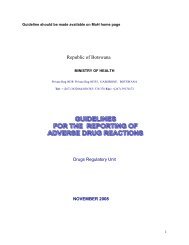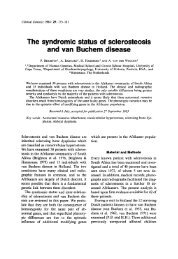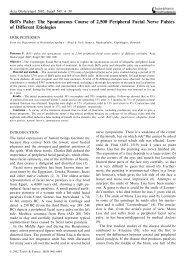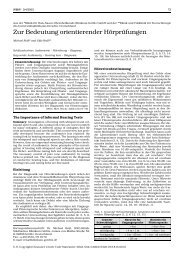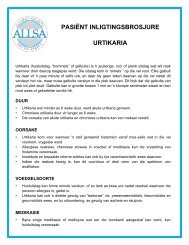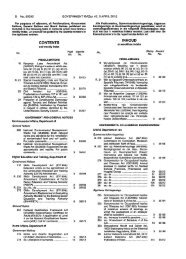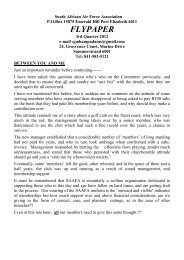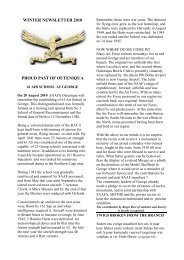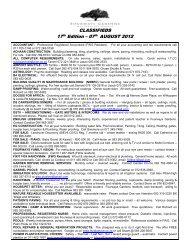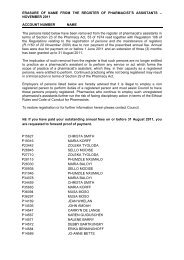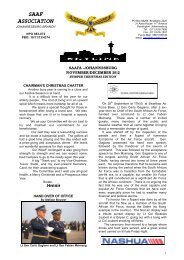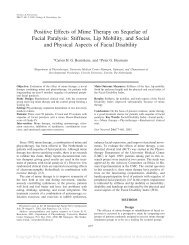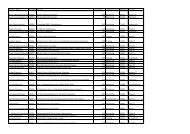SAAF ASSOCIATION - Admin
SAAF ASSOCIATION - Admin
SAAF ASSOCIATION - Admin
Create successful ePaper yourself
Turn your PDF publications into a flip-book with our unique Google optimized e-Paper software.
PICNIC IN THE PARK<br />
Family Musical Picnic at the Military Museum<br />
SUNDAY 19 TH AUGUST 2012<br />
11h00 TO 15h00<br />
Entrance Charge to Museum and Picnic :<br />
R60 adults, R30 Pensioners and Children<br />
WW2 Veterans FREE<br />
Highlights: SA Air Force Military Band<br />
Combined Tvl Scottish, SA Irish<br />
And Wits Rifles Pipe Bands<br />
Alwyn the Ventriloquist<br />
John & Dan Musical duo<br />
Veterans’ Commemoration<br />
Venue:<br />
The Ditsong National Museum of Military History,<br />
22 Erlswold Way (Cor Eastwold Way),<br />
Saxonwold Johannesburg<br />
<strong>SAAF</strong>A JOHANNESBURG LUNCH HELD ON<br />
27 TH JULY 2012<br />
Rob Milne spoke about new information on the<br />
Boer War at our lunch which had a very<br />
disappointing turnout of only 47 – the lowest this<br />
year. July, of course, is usually a bad month as<br />
people are ill or away.<br />
Rob Milne with his speaker’s gift. He is pictured<br />
with Bruce Harrison (Centre), the Chairman of the<br />
RAF Officers Club, who thanked him for his speech<br />
and Chairman Hennie, who introduced him<br />
SOME FRESH INSIGHTS INTO THE<br />
ANGLO-BOER WAR 1899-1902<br />
(from Rob’s speech)<br />
There were 3 balloon detachments attached to<br />
the Royal Engineers – a total of 20 observation<br />
balloons were brought to South Africa. They<br />
were made of rubberised sailcloth fabric and<br />
each filled with 11 000 cubic feet of hydrogen.<br />
Graded for heights of 4 000 feet at Aldershot,<br />
they battled for height where they were deployed<br />
at the high South African altitudes. There were 8<br />
balloons in Ladysmith during the siege that only<br />
achieved heights of 500 feet. By the fourth day of<br />
the siege, two had been lost to enemy shellfire<br />
and one in a storm.<br />
On 24 th October 1899 (soon after war’s<br />
commencement) two mysterious discs were<br />
observed moving in the night sky over the<br />
Transvaal, from Irene in the Pretoria area<br />
towards Springs. They were accompanied by<br />
“searchlights moving about the sky”, and were<br />
reported to General Joubert as being possible<br />
British observation balloons. If the balloons had<br />
already arrived in South Africa, they were many<br />
hundreds of miles away and no explanation was<br />
ever forthcoming. Today this event would have<br />
been classified as a UFO sighting!<br />
Captured British officers, including Winston<br />
Churchill and Captain Haldane, were held at the<br />
State Model School in Pretoria. Every afternoon<br />
a man walked his St Bernard dog past the Schol,<br />
tapping along the pavement with his cane. The<br />
prisoners quickly tumbled to the fact that he was<br />
tapping out the recent war news using Morse<br />
code. After Pretoria was captured by the British,<br />
a Mr Patterson received a commendation for his<br />
action by Lord Roberts as well as gifts from the<br />
British Officers who had been incarcerated.<br />
British by birth, Patterson had been a telegraphist<br />
employed by Transvaal Republic after taking the<br />
Oath of Allegiance. After the war, in 1911, he<br />
was appointed Postmaster of Pretoria. In 1917<br />
an article appeared in “Die Volkstem” accusing<br />
him of helping Captain Haldane to escape from<br />
the School on 12 December 1899. Patterson<br />
then sued the newspaper for 1 000 pounds in a<br />
civil claim for damages. Against the background<br />
of breaking his Oath, he was only awarded one<br />
pound plus costs. The judge remarked that as<br />
long as his conduct was approved, Patterson was<br />
satisfied, but when blamed he resented it.<br />
In 1914, twelve years after the war, a criminal<br />
libel case was brought against the minor<br />
politician, Jan Munnik by the Prime Minister Louis<br />
Botha. During an election meeting in Booysens,<br />
a working-class suburb of Johannesburg, Munnik<br />
had called Botha to account for 134 gold bars<br />
that went missing whilst Botha was Commandant<br />
General of the old Transvaal Republic and the<br />
Boers were retreating eastwards from Pretoria.<br />
The judge found in favour of Botha and on 17 th<br />
December 1915, the Appeal Court upheld the<br />
decision on the basis that a political candidate<br />
must “fight fair in an election”. The issue of the<br />
missing “Kruger Millions” was in fact never given<br />
the attention it deserved in this trial. According to<br />
calculations there are still 1 202 gold bars<br />
unaccounted for, which are worth R6.6 billion<br />
today!<br />
________________________________________<br />
EDITOR: Carol van Rensburg<br />
PRINTED BY: NASHUA, Johannesburg<br />
ENVELOPES & POSTAGE SPONSORED BY : Basil Hersov<br />
PHOTOGRAPHIC ASSISTANCE : Ian Andrew<br />
MASTHEAD: Designed by THE CHEESE HAS MOVED<br />
12



